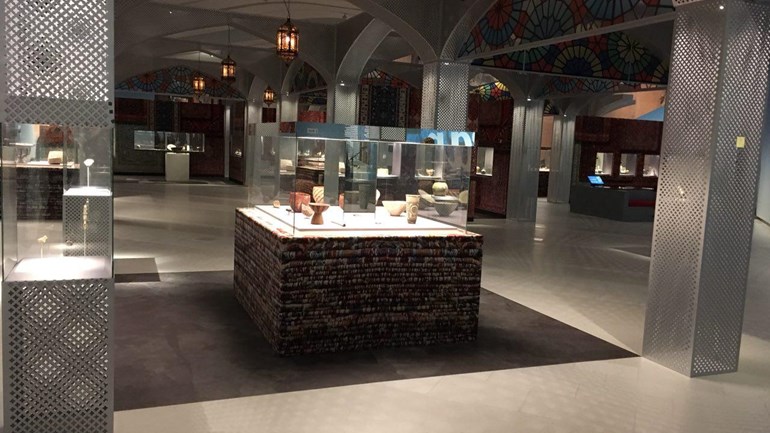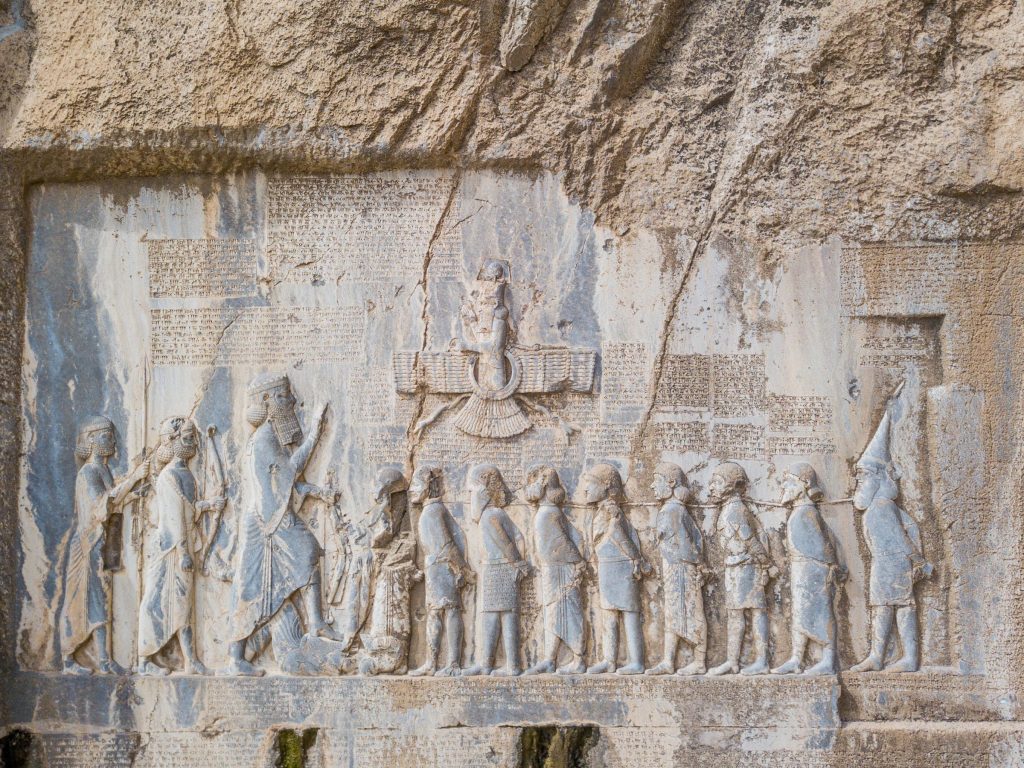By Ivo Dos Santos Martins
Warning: Enter the room with a big flock of people! Otherwise, you won’t get it!
Sure, you may like your exhibitions a little bit quieter. But, in this case, silence will just ruin the experience. This exhibition will be all the more engaging if the room is alive, crowded, populated by multiple noises and buzzing with a ton of tongues. What you need to understand, once you suspend your disbelief for a while, is that this is not an exhibition at all!
This is a bazaar! Granted, it is not exactly the Grand Bazaar of Tehran. Yet, the Drents Museum team managed to convey the basic impression of a Middle Eastern marketplace. The exhibition cases are upholstered with textiles mimicking Persian tapestries, the arches are decorated with colourful stained glass, and lacelike lamps hang above the small galleries. A few Persian style puffs and a large photograph of a modern-day bazaar tie up the illusion.

Figure 1: Impression of the exhibition room (Source: Drents Museum)
In the galleries of this fantastic place you can see Iran: cradle of civilization (Iran: Bakermat van de beschaving), an archaeological exhibition which is organized by the Drents Museum at Assen and hosts a collection of artefacts stemming from several Iranian archaeological sites. These objects, owned by the National Museum of Tehran, are exhibited outside of Iran for the first time.
Until November 18th, you are invited to walk-in and peruse at your pleasure six different shops, each illustrating a specific Historical period: The Beginning; Cities; Changes; Elam and Media; Golden Age; Iran and Islam. At these stands, you will be able to discover archaeological artefacts documenting almost each and every period of the history of human settlement in the Iranian region. From a Stone Age hand axe found at the Darband cave bordering the Caspian Sea (300.000 B.P.) to porcelain carafes and dishes offered by Sheik Safi to Sha Abbas I (17th century A.D.), and in between objects of various types from different archaeological sites, such as Chohga Zambil, Tall-i-Malyan, Deylaman, Hanadan, Pasargadae, Ardabil, and Susa.
In spite of this extensive and diverse coverage, a special place is reserved for the so-called Golden Age. Identified as the Golden Age par excellence, the Old Persian or Achaemenid Empire receives great emphasis throughout the exhibition. A few elements create this emphasis. First, as soon as you enter on the right, a large map displays the maximum reach of the Achaemenid conquests; second, a huge photograph of the Persepolis’ Apadana stairway reliefs practically envelops two walls of the room; third, Darius I Bisotun inscription is presented on a large-scale 3D reproduction (it is only a pity that unlike the relief showing Darius I subduing rebels from many nations, the trilingual inscription is no more than a blurry photograph); fourth, a copy of the Egyptian statue of Darius I is exhibited with special attention been given to its hieroglyphic inscription listing the names of 24 lands under the Great King’s rule.
Such emphasis is in a way understandable. The Achaemenid Empire was not only the most extensive but also the only uncontested superpower of its time (c. 550-330 BCE). However, to highlight a political entity that lasted little more than two centuries out of a long history requires some other explanation. That reason, I believe, is interwoven with the message the exhibition wishes to convey.
Diversity and tolerance are the keywords of the exhibition. A note of multiculturality runs through every feature of the exposition. Multiculturality is to be found in the bazaar theme and on the range of objects that document the diverse cultural make-up of modern Iran. The same message explains the emphasis on the first Persian Empire. The artefacts on display that stem from this period fit perfectly with the message of multiculturality.
And rather unsurprisingly so, as the imperial power that produced these objects was also keen on presenting the Empire as a collaboration between different cultures dully represented on procession on the steps of the Apadana, kneeling reverently at the feet of Darius I, and humbled under fetters at Bisotun. The organizers brought the message of diversity and tolerance to our own time. On two small screens, you can watch interviews with modern Iranians, who are currently based in the Netherlands, and hear their insights on their history and cultural heritage.

Figure 2: Bisotun Relief (Source: Drents Museum)
Definitely, this exposition has a point to make. The exhibition was carefully planned so as to communicate the intended message of tolerance to its visitors, and perhaps also to its partners. While factual history was not disregarded, some periods and events were brought to the foreground. Is this a deliberate attempt to shape the memory of Iran’s history in the eyes of a Dtch audience? Or, since the objects on display required diplomatic immunity to be issued by the Dutch Ministry of Foreign Affairs, is the exhibition making a point on international relations?
In any case, a story about history is being told here, and, to some degree, Iran: cradle of civilisation (Iran: Bakermat van de beschaving) engages in an exercise of “intentional history”.
Until November 18th you can still catch a glimpse of this buzzing bazaar and hear the story for yourself. In case you wish to find out more, Ex Oriente Lux organizes an event at the Drents Museum on September 22nd with three lectures concerning the Achaemenid and the Sassanid Persian Empires and on the exhibition itself.

